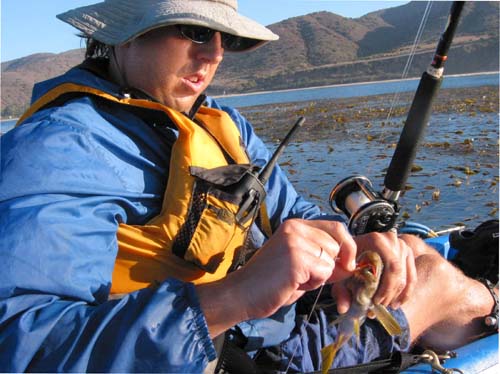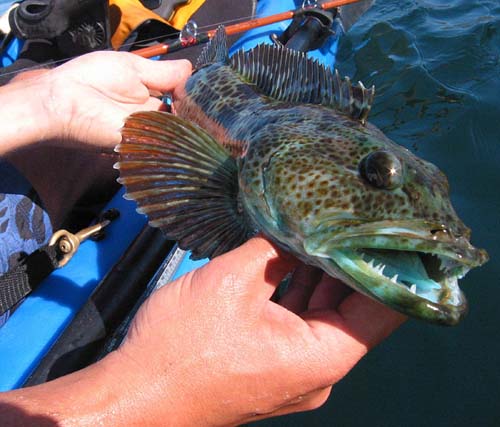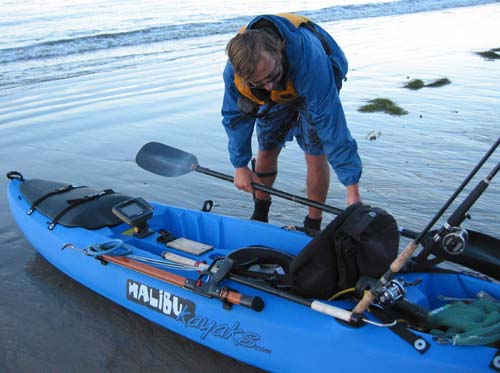| Many are finding kayaks to be fishing's....
NEW WAVE |
|
|
Originally featured in the Los Angeles Daily News Dec. 5, 2002
|
By Bill Becher
Surf's up, dudes. But that's a bad thing if
you're a kayak angler. |
| Timing is everything. As any surfing
gremmie knows, waves build in sets like a symphonic crescendo -- then there's a lull. That's the
window of opportunity to get outside before the next big wave knocks you over and pounds you
into the sand. Southern California salt-water anglers are finding kayaking is a quiet, inexpensive, and fun way to fish coastal water. There's always a chance of hooking a fish that will tow your kayak. Morton once spent three and a half hours being pulled several miles by a 235-pound thresher shark before he landed it. Morton, who lives in West Hills, is a professional bass guitar blues and jazz musician when he's not being dragged by sharks. He paddles a sit-on-top kayak, the type favored by most kayak anglers. When the time seems right Morton pushes off and paddles over the breaking waves to the calm water outside the surf line. Once committed to a launch -- keep paddling say experts. Don't get stuck in no man's land - the place between the soup of the spent waves and the calm beyond the breaking waves. Kayakers point one blade of the paddle forward in the "ninja stroke" when a wave breaks over their kayaks. This prevents the water from forcing the paddle back and dislocating a shoulder. In this position you're also ready to start paddling as soon as the wave breaks. |
|
 |
After you're through the surf line everything calms down. The
only problem is you eventually have to get back through the surf. It you don't want the surf launch adventure, you can start from a sheltered spot, like those at King Harbor, Channel Islands Harbor, and other places along the Southern California coast. |
| Morton has outfitted his "yak" - as
kayakers call their craft -- with rod holders and a fish finder. That's standard these days -
some kayak fishers have even installed battery operated live-bait tanks on their yaks. Customizing is one of the joys of kayak fishing, says Morton, whose website
kayaksportfishing.com, includes equipment tips and fishing journals. Morton is fishing two shrimp-like surf-fishing flies tipped with a piece of squid. He's also had good results with six to seven inch plastic swim baits. Morton likes a long enough rod -- at least seven feet -- to be able to maneuver the rod tip around the bow of his kayak. |
|
 |
Today Morton lands a mixed bag: an undersized lingcod, a
couple of sanddabs, several olive rockfish and some calico bass. All go back in the water
to get bigger. "What makes people so addicted to kayak fishing is being part of the environment," says Morton. "Kayak fishing doesn't have to be extreme and it's not just about saving money. You go slow enough to pick up on your surroundings." |
| When it's time to head back to the beach Morton
lashes down his gear in case of spill in the surf. He suggests placing rods inside the kayak's
hatches to avoid the chance of getting snagged on fishing line or hooks if you get dumped.
He picks a landing spot away from swimmers and surfers. Watching the waves, Morton keeps the kayak at a right angle to the waves while back paddling until he finds a lull. Then he paddles hard behind a wave. Morton times his landing perfectly, hops off his kayak and hauls it up the beach. Sweet ride, dude! Originally appeared in the Daily News of Los Angeles. Text
and
photos
copyright 2002© Bill Becher
|
|
